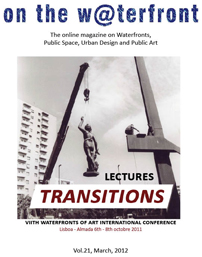Public space and art in Mexico during the twentieth century. From dictatorship to democracy
Keywords:
Mexico, Art, Public ArtAbstract
In Mexican cities the changes in public spaces and the inclusion of art are closely linked to the periods of time where the authority established radical positions that determined social and urban nature aspects that impacted in the way of making a city, the case of dictatorships was a truth in Mexico because the thoughts of who exerted his power above the country were perfectly marked. The transitions or changes undergone in these spaces can be visualized in XX century at Porfirio Diaz’ regime, that lasted more than thirty years where the country was impacted by the industrialization and the introduction of eclectic and nationalistic art and architecture, to the period of the revolution where it was wanted to deprive an authoritarian regime and to look for an identity, fact that lead to the proclamation of the Constitution (1917), later in 1929 the permanence of a political party which lasted seventy years in the presidency that was exhausted in commemorating political personagesy in parks and gardens, until the denominated alternation, sign of an evident democracy. All these periods have characterized Mexico and its open spaces, including the social activities. This work includes the study of public space developed during XX century which includes Porfirista period, post revolutionary or constitutionalist stage characterized by a single-party foresight with the appearance of the PNR3 thereinafter PRI4, three causes that have defined the course of Mexican public spaces that have been inherited until present time, in which positions with remarkable uropean influence in gardens, avenues, sculptures and urban furniture can be showed. But as well as an influence of other countries was exerted during XX century also it was looked for setting deeply a new history by mean of a) the conservation of the past pre-Hispanic (museums), b) the restoration of architectonic monuments, c) the scientific archaeology, and the touristic use of the heritage. Neo-Prehispanic positions with which the national bourgeoisie tried to create a culture that included to every social group in Mexico. (Shchavelzon, 1988). The transitions during XX century caused impact regarding the use of the public space by all those social movements that took place in the sixties, seventies or eighties in the searching of answers and inclusively it was spoken about their monopolization by the dominant political group: The public space was until decades ago the environment where the policy notion tightened to the procurement and retention of the power, and it rejected by useless! or subversive! the defense and the promotion of the communitarian interests. In Mexico, during the most of 20th century, th public space is monopolized by the government. (Monsivais, 2008). It is important to mention that XX century is a period where a great amount of open spaces and sculptural monuments or objects with a remarkable partisan influence were built (Hernandez, 2009). Therefore throughout the past century the public space underwent a series of changes that affected in a radical way the conception of the same as well as their physical aspect and the way to use them, there is not doubt that XXI century will be a period of changes mainly in security and social cohesion aspects.Downloads
Published
2012-03-10
How to Cite
Hernández, Adriana. 2012. “Public Space and Art in Mexico During the Twentieth Century. From Dictatorship to Democracy”. on the w@terfront. Public Art.Urban Design.Civic Participation.Urban Regeneration, no. 21 (March):21-40. https://revistes.ub.edu/index.php/waterfront/article/view/18753.
Issue
Section
Articles
License
The
 licence allows: Share — copy and redistribute the material in any medium or format and Adapt — remix, transform, and build upon the material for any purpose, even commercially.The licensor cannot revoke these freedoms as long as you follow the license terms. Author's rights are protected by the ISSN 1139-7365. On the w@terfront has no restrictions respect the copyright by the authors and does allow authors to retain the publishing rights without restrictions.
licence allows: Share — copy and redistribute the material in any medium or format and Adapt — remix, transform, and build upon the material for any purpose, even commercially.The licensor cannot revoke these freedoms as long as you follow the license terms. Author's rights are protected by the ISSN 1139-7365. On the w@terfront has no restrictions respect the copyright by the authors and does allow authors to retain the publishing rights without restrictions.This journal does not apply any type of charge to the authors for the presentation or processing of the articles.







